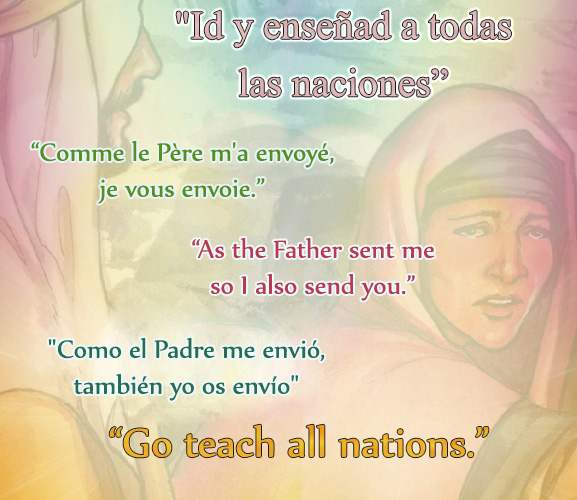 As we work our way through our Founder’s writings, it is intriguing to see how often he refers to Quasimodo Sunday as “the principal feast of the Association” or “the patronal feast of the Association”. Why was this Sunday so special that it was our “principal” feast? How could it be our “patronal” feast? Why was the Gospel of that particular Sunday so important that it was even represented on our coat-of-arms by the olive branches signifying the ‘Peace be with you’? And why, more than any other Sunday or solemn feast of the year, was Quasimodo Sunday followed by forty days of prayer to the Holy Family?
As we work our way through our Founder’s writings, it is intriguing to see how often he refers to Quasimodo Sunday as “the principal feast of the Association” or “the patronal feast of the Association”. Why was this Sunday so special that it was our “principal” feast? How could it be our “patronal” feast? Why was the Gospel of that particular Sunday so important that it was even represented on our coat-of-arms by the olive branches signifying the ‘Peace be with you’? And why, more than any other Sunday or solemn feast of the year, was Quasimodo Sunday followed by forty days of prayer to the Holy Family?
We find the answer in the first issue of the Annals of the Association of the Holy Family published in 1831. There, in the section on indulgences, we see that one of the days on which a plenary indulgence was granted to the Association of the Holy Family was “The Feast of the Most Holy Family, (Quasimodo Sunday).”
In the time of our Founder, there was no feast of the Holy Family in the general Church calendar. This is not really surprising since devotion to the Holy Family began only in the seventeenth century. The feast was celebrated in various dioceses on a Sunday in Eastertide, the last Sunday in May or the third Sunday in November. Bordeaux, which had been consecrated to the Holy Family as early as 1675, celebrated it on the second Sunday of Easter, known as Quasimodo Sunday. From homily notes which he wrote for that feast, we see that Fr. Noailles read the gospel of the day (Jn 20:19-31) in the light of the feast, and saw in it the story of the foundation of the Holy Family as well as its apostolic mission. He made the comparison between the apparition of Jesus to the frightened apostles hidden in a room and the Miraculous Benediction when Jesus appeared in the monstrance to a small number of poor and vulnerable women hidden in a humble dwelling in the first years of the foundation of the Holy Family. Jesus blessed the two groups. Both were reassured by the apparitions, and given confidence through the peace they received. Fr. Noailles also saw the mission of the Holy Family mirrored in the mission of Jesus and the apostles, “As the Father sent me so I also send you.” (And Fr. Noailles added, “Go teach all nations.”) He reflected that as Jesus Christ was sent not just for the salvation of a few souls but for all, so too, the members of the Holy Family are sent not for one particular apostolate but for a variety, and not for any one class of society but for all.
The feast of the Holy Family of Jesus, Mary and Joseph continued to be celebrated on various dates, as a local Feast until 1921 when Pope Benedict XV extended the Feast of the Holy Family to the whole Church to be celebrated on the Sunday within the octave of the Epiphany. Then, in 1969, the new Roman calendar fixed the Feast of the Holy Family for the Sunday within the octave of Christmas (or December 30) with new texts both for the Eucharist and for the Liturgy of the Hours. That is still the position at the present time.
When the Feast was first moved, the Directress General Mother Raphael Tignet, decided that we would continue to celebrate Quasimodo Sunday as a reminder of our mission. She omitted to mention in her circular that our Founder also used the gospel to remind us of our foundation.
The gospel for the second Sunday of Easter is still the same as it was in our Founder’s lifetime – Jn 20:19-31. One of the two possible Entrance antiphons is still the one whose first word – Quasimodo – gives the Sunday its name. (Sundays used to get their name from the first word of the Entrance Antiphon in Latin. We still have Gaudete and Laetare Sundays in Advent and Lent.)
So, let us remember why the Second Sunday of Easter is given to us as one of our special Holy Family Feasts in our Constitutions and thank God for our foundation and our common universal mission.
Áine Hayde
Britain & Ireland unit
